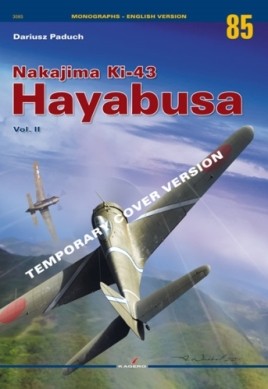Nakajima Ki-43 Hayabusa Monograph 85: Volume II
Background from the Website
Nakajima K-43 Hayabusa, code-named Oscar by the Allies, was the Imperial Japanese Army’s equivalent of the Zero fighter in service with the Imperial Navy. In combat units, the machine replaced the aging Ki-27. Manufactured in large numbers, the fighter remained in frontline service until the end of the war. By the time its final version entered production, the development of its successor – the Ki-84 – had already started. The Ki-43 was a very maneuverable machine, but in many areas it was inferior to its adversaries. Despite its fragile design, poor armament and almost no armored protection, the Ki-43 was well-liked by the Japanese pilots and it became a symbol of the Imperial Japanese Army Air Service. Hayabusa was the pinnacle of the Japanese fighter design development until the lessons learned in the Pacific laid the ground for new approaches to the construction of tactical aircraft.
Contents
Each page has anywhere from one to three black and white images with accompanying text. The images in some instances are a bit washed out and grainy, but still offer some detail. Several of the images reveal the notorious poor paint applied to Japanese military aircraft. Good examples for the scale modeler. The back cover and last four pages show full color plans with right and left side views of Ki-43-I, and -II models.
There are no chapters per se, but headings at the top of the various pages show the theater of operations.
- Pages 3 - 8 History of the organizational structure of the Imperial Japanese Army Air Service
- Pages 8 - 19 Malaya and Singapore (December 8, 1941 - February 15,1942)
- Pages 19 -28 Dutch East Indies (December1941 - August 1945)
- Pages 28 - 57 Burma (December 1941 - August 1945)
- Pages 58 - 65 New Guinea, Guadalcanal (December 1942 - July 1944)
- Pages 65 - 67 China (1942 - 1945)
- Pages 68 - 69 Other Fronts
- Page 70 Philipines
- Page 71 - 72 Okinawa 1945
- The above pages of this publication offer the same format documenting dates, air groups for the Japanese and Allied forces, aircraft types involved in the air battles, claimed and actual kills, plus pilots killed and those surviving being shot down.. The air actions were quite fierce at times, with the Japanese being strong aggressors. Gradually the tide turned against the Japanese with the introduction of newer aircraft types by the allies. The time of dominance by the Hayabusa was over.
- Pages 72 - 73 In Defense of the Home Islands
- Due to the lackluster performance and poor weapons the Ki-43 fighter did not play a significant role in the defense of the home islands. The Ki-43 was involved in the battle for Iwo Jima, but the majority of the Japanese aircraft were lost in battles with the US Naval forces.
- Pages 73 - 75 Ki-43 in Foreign Service
- Thailand purchased 24 Ki-43-II in 1943, and these aircraft were the most modern aircraft flown by the Thai air force. The Thai Ki-43's encountered Allied aircraft on several occasions with no real success. The last aircraft was withdrawn from service in 1949.
Between 1943 and 1945 the Manchikuo National Armed Forces operated at least five Ki-4 II's. These aircraft attempted to engage B-29's, but with zero success.
China also captured a number of Ki-43's where were flown by the Nationalists and the Communists. These aircraft were initially flown by Japanese POW's who gradually trained Chinese pilots. The last Ki-43 was retired in 1952.
North Korea took over a number of Ki-43's after the war and used them as training aircraft. They were eventually replaced with Soviet-built aircraft.
After the war Indonesian insurgents used upwards of a dozen Ki-43 aircraft to battle British and Dutch troops. By 1947 only a single Hayabusa remained in service. This aircraft is now on display at the Dirgantara Udara Yogyakarta Museum. https://en.wikipedia.org/wiki/Dirgantara_Mandala_Museum
Upon the end of hostilities the French utilized several Japanese types of aircraft, including the Ki-43 to attack the Viet Minh. The last Ki-43 was decommissioned in February 1946.
- Thailand purchased 24 Ki-43-II in 1943, and these aircraft were the most modern aircraft flown by the Thai air force. The Thai Ki-43's encountered Allied aircraft on several occasions with no real success. The last aircraft was withdrawn from service in 1949.
- Page 76 Selected Bibliographies
- The last four pages include color plates of the Ki-43-II and -1
Conclusion
The many black-and-white images may prove informative to the scale modeler, even though many lack clarity and close up details. The weathering effects on the paint on several of the aircraft shown is interesting. Most of the photos are grainy, but still offer detail for the scale modeler and aircraft enthusiast. I found the cover artwork stunning. Recommended as a nice addition to any aircraft reference library.
I wish to thank Casemate Publications and IPMS/USA for the opportunity to review this publication.







Comments
Add new comment
This site is protected by reCAPTCHA and the Google Privacy Policy and Terms of Service apply.
Similar Reviews